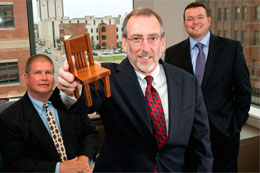|
Capitalizing on Benefits
The sweet spot: Benefits boost revenue and retention
Focus on benefits drives growth in agency's volume and profits
By Len Strazewski
Growth in employee benefits sales doesn’t happen overnight and it doesn’t come easily, says Greg Downes, president and chief executive officer of Gibson Insurance Group in South Bend, Indiana.
But a long-term commitment to building human and institutional resources for employee benefits services can pay dividends, he says. Big dividends and rapid revenue growth.
As the agency celebrates its 75th anniversary this year, it is also celebrating landmark growth in its employee benefits revenues and—for the first time—an influx of new property/casualty clients, attracted by the agency’s success with employee benefit plans, Downes says.
In the first two years of Gibson’s five-year employee benefits development strategy, revenue from group health, life and disability sales has increased more than 50% each year to more than 22% of total sales, on its way to a projected 35% of revenue by the end of this year, and as much as 50% by 2011, executives say.
Meanwhile, cross-selling within the agency’s customer base has increased 300%, Downes says, as more property/casualty clients sign on as employee benefits customers, and as a growing number of employee benefits clients rediscover the agency’s risk management strengths on the property/casualty side.
Gibson has 90 employees in three offices, including locations in Indianapolis and Plymouth, Indiana. Eighteen full-time employees work in the employee benefits services division. The agency specializes in mid-market clients with 50 to 4,000 employees; however, executives say the agency’s “sweet spot” remains local manufacturers, municipalities, media companies and financial services firms with 100 to 500 employees.
An Intersure partner agency, Gibson has been a local leader in providing risk management expertise to mid-market companies in Indiana and Michigan industrial areas. The agency motto, “Strength Against Risk,” is illustrated in marketing and advertising by a sturdy chair with four legs representing four components of a strategic program to control risk: risk management, loss prevention, claims management and insurance.
In the last several years Gibson has been recognized with several awards for its risk management practice, including being named a Best Practices agency for the 14th consecutive year by the Independent Insurance Agents & Brokers of America. Only three other agencies in the state of Indiana received this honor in 2007.
Best Practices firms are agencies that take part in an annual study that has become a prestigious recognition of the superior accomplishments of the top independent agencies in the country. In addition, Gibson was named HR Business of the Year by the Michiana Chapter of the Society of Human Resources in 2007, received a Samaritan Business Award in 2006 from Samaritan Center, and in 2004 was designated Agency of the Year by the Independent Insurance Agents of Indiana.
Building benefits
Employee benefits isn’t a new business for the agency, notes Downes, but it had never achieved the size and importance of the property/casualty business.
Gibson first attempted to build a benefits practice in the early 1980s, but after an initial surge of new business, benefits revenue shrank to only about 10% of total revenue as competition increased from national brokers, third-party administrators and employee benefits consultants.
However, as a prolonged soft market for property/casualty insurance pressured Gibson’s revenue growth and U.S. health insurance costs continued to escalate, executives soon realized that a renewed commitment to providing employee benefits could help the agency build long-term growth.
“There’s certainly no soft market in employee benefits lines,” notes Keith Stone, vice president, chief operating officer and chief financial officer. “Health care premiums continue to increase every year. While we haven’t seen the dramatic double-digit premium increases of years past, our customers are still reporting steady but more manageable increases in the single digits—about 5% to 9%.”
Managing those increasing costs provides both a challenge and an opportunity for the agency, Stone says; and so far, accepting the challenges has proved rewarding. “We’re still in the middle of our employee benefits strategic process, but our business is continuing to grow along the lines we envisioned when we began our new commitment,” he says.
The agency took its first step in building its new employee benefits division in 2005 with the hiring of Tim Leman as employee benefits practice leader. Leman now also holds the title of “chief growth officer.”
Leman, a former employee benefits specialist at Aon and Willis Group Holdings, brought a sophisticated new approach to employee benefits that was consistent with the agency’s risk management practice.
Under Leman’s leadership, the agency began to address clients’ employee benefit needs in a systematic, strategic way, beginning with a more sophisticated understanding of their needs.
“We began by taking an inventory of the resources we had within the agency and what we would need to develop a value proposition for our clients that was comparable to our reputation in the property/casualty risk management field,” Leman says.
The first step was to change the way the agency’s employee benefits producers thought about employee benefits risk management.
“The days of submitting proposals to as many health insurers as you could and waiting for the quotes to come in are long gone,” Leman says. “There are many fewer health insurers in the market these days and very little to be gained from the old-fashioned bidding process.
“Our goal is to help our clients manage and control their employee benefits costs and provide them with appropriate benchmarking data to help them develop a strategic plan for their future. When that plan is in place, we can also help them put the proper tools in place to achieve those goals.”
The agency teamed with a certified, national benefits actuarial firm to provide benchmarking data to help employers understand where they should be in terms of employee benefits plan design. The agency also developed relationships with health plans and health service providers that could be matched with their clients, including local leaders Anthem Blue Cross and Blue Shield/WellPoint Health Networks and Principal Wellness Company
Another critical component of the agency’s long-term employee benefits marketing strategy, Leman says, called for a greater commitment to the education of client employers on health care and related cost issues and the education of client employees on their plan options.
Health care summit
In February, the agency conducted its Second Annual Healthcare Summit for local employers, featuring consultants and health insurance industry experts from Milliman, Principal Wellness, and local health care and physician networks.
The program was designed to provide clients and prospective clients with insight into health industry innovations and resources that could help employers meet their cost control goals and educate employees to become better health care consumers.
The agency also took its education initiative to the street level, working directly with client employees, emphasizing small group and one-to-one meetings in preparation for enrollment.
For example, last year, Supreme Corporation in Goshen, Indiana, which manufactures specialty vehicles for military and industrial use, signed on as an employee benefits client, according to Mike Bellovich, Supreme’s vice president of human resources. The company has 2,300 employees and manufacturing facilities in six locations around the country.
After years with the same local third-party administrator and steadily increasing costs, the manufacturer was ready for changes in both its employee benefit plan design and health management philosophy, Bellovich says.
Gibson negotiated more favorable administrative services rates with Anthem WellPoint and introduced the company and its headquarters employees to consumer-directed health plans (CDHPs), which provide financial and tax incentives for consumers who make positive health and lifestyle choices, Bellovich says.
To make it happen, the agency conducted a seminar for Supreme employees to explain the new plans and the educational resources that would help employees use the plans successfully. About half of the headquarters employees chose the new plan design.
“Our employees had a lot of questions. This concept was very new to them, so Gibson came back and conducted one-to-one session with employees, working with them until virtually every question was answered,” Bellovich says.
Supreme also will introduce a wellness program next year and is planning for a company-wide rollout of the new health plan in 2010, Bellovich says.
Leman says this long-term strategic approach is what the agency is all about—in both risk management and employee benefits.
“For every client, we have to not only lead them into the employee benefits strategy that is appropriate right now, but also help them develop a long-term plan that will take them to where they want to be in the future,” he says. *
GIBSON CONDUCTS ANNUAL SURVEY
Who are the prospective employee benefits clients of Gibson Insurance Group, and what kinds of health care benefits do they offer? Periodically, the agency conducts a Benchmark Benefits Survey of mid-sized regional businesses with 50 or more employees to obtain information about their employee benefits programs. The agency’s employee benefits specialists use the data to help their own employee benefits clients understand and budget for the changes, costs and trends associated with their benefit plans.
In 2007, nearly 4,000 employers in 31 cities participated in the survey, representing 2.6 million employees and about $21.5 billion in health care spending. About two-thirds of the employers (64%) had fully insured employee benefits plans, 8% had minimum premium plans and 28% were self-insured.
Among this group, the median preferred provider organization (PPO) deductible was $500 for in-network and $800 for out-of-network coverage in 2007, an increase from $300 in network and $500 out of network in 2005. About 27% of survey respondents offered flexible savings accounts with debit cards, but only 6% offered employees consumer-directed health plans (CDHPs) with high-deductible catastrophic coverage above a tax-qualified savings account.
The average annual employee premium in 2007 was $346 for individual and $984 for family coverage, up from $313 individual and $903 for family coverage in 2005.
In the Michigan/Indiana region that is Gibson’s largest service area, 148 employers participated in the survey, representing 61,000 employees and $400.4 million in health care spending. The median PPO deductible was $500 in network and $1,000 out of network in both 2005 and 2007. Premiums tracked the survey’s national average, but about 22% of these regional firms offered CDHPs in 2007, up from about 8% in 2005.
The agency has announced a new Benefits Benchmark Survey for 2008. Information is available on the agency’s Web site (www.gibsonins.com). |
|
|
| |
 |
| |
Gregory S. Downes, CPCU, CLU, ChFC, AFSB, AI, Gibson Insurance Group President and Chief Executive Officer, front center, illustrates the agency’s strategic program to control risk with a sturdy chair with four legs representing four components: risk management, loss prevention, claims management and insurance. Joining Greg are, far left, Keith A. Stone, CPA, Vice President, Chief Operating Officer and Chief Financial Officer; and Tim D. Leman, Vice President, Chief Growth Officer and Employee Benefits Practice Leader. |
| |
“There’s certainly no soft market in employee benefits lines.”
—Keith A. Stone
Vice President/COO/CFO
Gibson Insurance Group
|
| |
|
| |
 |
| |
Chad R. Hahn, Gibson Insurance Account Executive (left), discusses employee benefits with Mike Bellovich, Vice President of Human Resources for Supreme Corporation in Goshen, Indiana, one of Gibson’s clients. Behind them (from left), Gibson’s Manager of Employee Benefits Cheryl L. Ashbaugh; Supreme’s Benefits Administrator Cecilia Castaneda; and Gibson’s Client Representative Diana L. Weatherly also confer about the company’s benefits program. |
| |
 |
| |
Gibson executives (from left): Greg Downes, Keith Stone, Cheryl Ashbaugh and Tim Leman. |
| |
 |
| |
| Gibson’s Employee Benefits Team specializes in mid-market clients with 50 to 4,000 employees. |
|